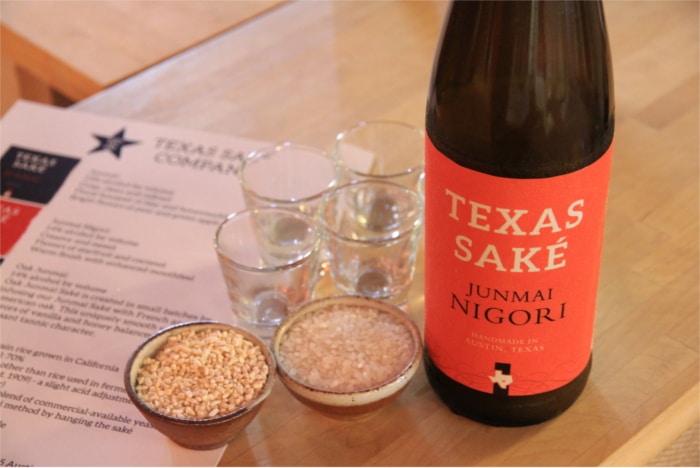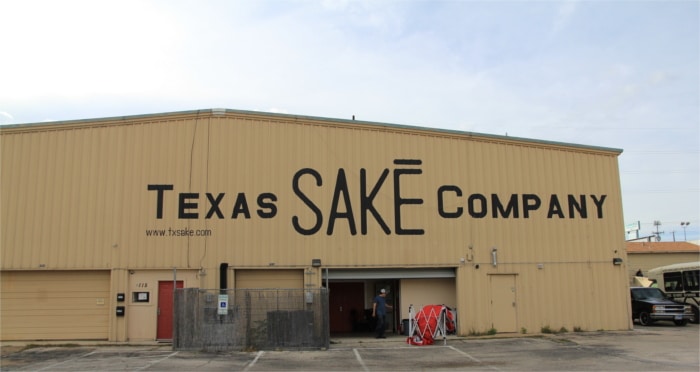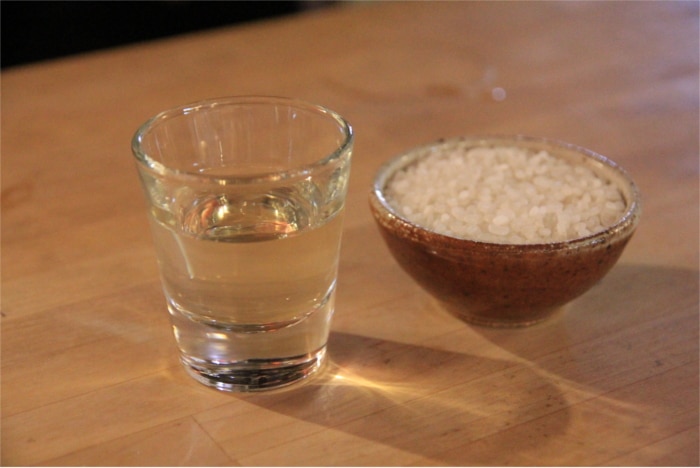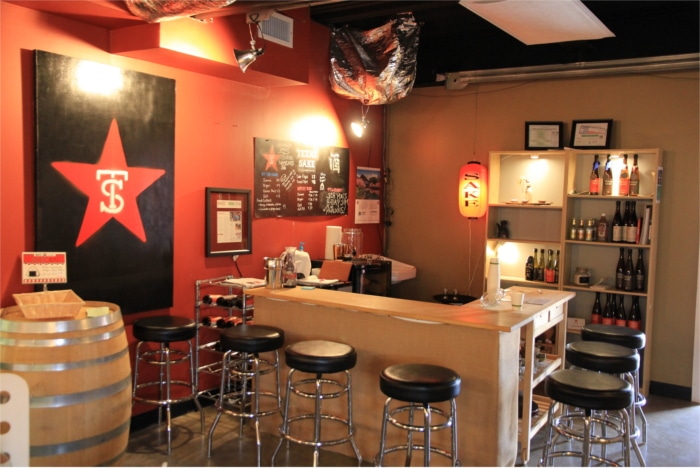
Guest article by Caitlin Johnson
Sake isn’t actually rice wine. Yes, it’s sipped like a fine wine, but that doesn’t make it wine. Wine requires fruit for fermenting. Since there is no fruit, just rice…you get the idea.
I recently went to check out how one company in Austin is putting an American spin on this 2,000-year-old drink. I got to meet Jeff Bell, the Toji or master sake brewer at Texas Sake Company. We sipped and chatted as he cleared up common misconceptions about sake, and shared what the brewery is working on and what the sake-brewing process is all about.
Texas Sake Company Origins

Texas Sake Company on North Lamar in Austin
Sake is considered a rice-based mash, and its creation is similar to brewing beer. So I wasn’t too surprised when I found out Austin’s local sake brewery, Texas Sake Company, is owned by Strange Land Brewery.
The guys behind Strange Land Brewery (Adam Blumenshein and Tim Klatt) bought the sake brewery just in time. The previous owner was about to close the business down. Blumenshein and Klatt asked their friend, Jeff Bell, to be the Toji.
Bell began making sake at home while also running the sales floor at Austin Homebrew Supply (where he originally met the guys at Strange Land). He loves Japanese culture, which he immersed himself in before beginning to brew sake.
Traditional, With American Spin

Texas Sake Company currently distributes two types of sake
Located off North Lamar, Texas Sake Company is one of the rare sake breweries in the country. Right now, they distribute two types of sake: Junmai and Junmai Nigori.
Junmai actually means sake, and it’s what you are probably most familiar with if you’re a fan of sake or have experienced the drink before. Texas Sake Company’s Junmai is filtered and pasteurized, making it crisp and semi-dry, with tastes of green apples and pears.
On the other hand, I prefer Junmai Nigori. Its made from the sakekasu, or the lees left over from sake production that can also be used for pickling! Unlike Junmai, Nigori is unfiltered and watered down to bring the ABV to 14 percent. You’ll taste flavors of oats, hints of creaminess and a cozy finish.
You can head to Texas Sake Company’s taproom for more varieties and to check out what Bell is currently working on. During my visit, he let me check out one of his newest mixtures: Oak Junmai. Bell toasted his own oak chips for six hours, blending them with toasted French oak. The combination gives this sake a chocolate, tannic feel. Whisky lovers will want to keep their eyes open for this sake to hit shelves soon!
Blending oak flavors into sake isn’t happening in Japan, where the drink has a history that extends back 2,000 years. That’s what Bell and Texas Sake Company love most. “We’re not bound by traditions,” Bell explained as he poured me chilled sake. (What? Shouldn’t this stuff be heated up!?) Instead, he’s making “punk rock sake” with the American spirit deeply rooted in the heart of the business.
Three Simple Ingredients

Sake is made from three simple ingredients
Sake is made with three simple ingredients: koji, rice and water. Texas Sake Company gets their rice and koji from California, but Bell looks forward to growing his own koji in the near future.
Koji is rice that has mold growing on it. By chilling the koji, the mold growth can be stabilized. Next, Texas Sake Company cleans the rice by rinsing it heavily. This rinse polishes the rice and makes it very fine. As the rice tumbles and more of the husk is removed, the pieces become finer and finer. Only 70 percent of the rice is left.
After soaking for an hour, the rice-based mash is steamed, to puff up and stretch out all the starches. The enzymes start eating into the starches, effectively destroying them. What’s left is a small white dot on the koji that shows where it was attached to the stalk. This is called “the sweet spot.”
The basic process is strikingly similar to the mashing stage of brewing beer. Which makes it a bit strange that the Texas Alcoholic Beverage Commission classifies Texas Sake Company as a winery. Bell thinks the business should be classified as a brewery.
Unlike traditional sakes, Bell partially filters his sake and never adds extra alcohol. A lot of sakes include vodka to classify the product as a “non-infused wine,” increasing profitability. Bell also avoids double pasteurizing his sake, which is what stops the cycle of fermentation.
Future Plans for Texas Sake Company

Tasting room at Texas Sake Company
This is going to be a big year for Texas Sake Company. Bell explained that he feels the business is finally gaining traction and picking up in popularity, not just in central Texas, but worldwide. Plans for 2017 include continuing to build up the taproom, planning more fun events and staying connecting with the local community.
Texas Sake Company is located at 5501 North Lamar Blvd., behind BookWoman and Cloth Pocket. Current hours are Friday and Saturday from 6 to 11 p.m. You can also keep your eyes open for their bottles of sake at local Japanese restaurants and area Whole Foods Markets. Facebook has up-to-date information on upcoming events. Visit the company’s website here.
@theAustinot wants to know:
Have you tried sake before? What did you think?
Caitlin is an Austin-based craft beer blogger and writer. When she’s not taking advantage of all the great drinks and eats in this city, you can usually catch her out exploring the Greenbelt or doing some vintage shopping.

Leave a Reply